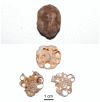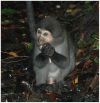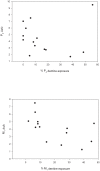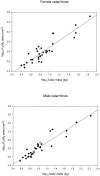Hard-object feeding in sooty mangabeys (Cercocebus atys) and interpretation of early hominin feeding ecology
- PMID: 21887229
- PMCID: PMC3162570
- DOI: 10.1371/journal.pone.0023095
Hard-object feeding in sooty mangabeys (Cercocebus atys) and interpretation of early hominin feeding ecology
Abstract
Morphology of the dentofacial complex of early hominins has figured prominently in the inference of their dietary adaptations. Recent theoretical analysis of craniofacial morphology of Australopithecus africanus proposes that skull form in this taxon represents adaptation to feeding on large, hard objects. A modern analog for this specific dietary specialization is provided by the West African sooty mangabey, Cercocebus atys. This species habitually feeds on the large, exceptionally hard nuts of Sacoglottis gabonensis, stereotypically crushing the seed casings using their premolars and molars. This type of behavior has been inferred for A. africanus based on mathematical stress analysis and aspects of dental wear and morphology. While postcanine megadontia, premolar enlargement and thick molar enamel characterize both A. africanus and C. atys, these features are not universally associated with durophagy among living anthropoids. Occlusal microwear analysis reveals complex microwear textures in C. atys unlike those observed in A. africanus, but more closely resembling textures observed in Paranthropus robustus. Since sooty mangabeys process hard objects in a manner similar to that proposed for A. africanus, yet do so without the craniofacial buttressing characteristic of this hominin, it follows that derived features of the australopith skull are sufficient but not necessary for the consumption of large, hard objects. The adaptive significance of australopith craniofacial morphology may instead be related to the toughness, rather than the hardness, of ingested foods.
Conflict of interest statement
Figures






Similar articles
-
Sex and age differences in the diet and ingestive behaviors of sooty mangabeys (Cercocebus atys) in the Tai Forest, Ivory Coast.Am J Phys Anthropol. 2011 Jan;144(1):140-53. doi: 10.1002/ajpa.21402. Epub 2010 Oct 5. Am J Phys Anthropol. 2011. PMID: 20925080
-
Dietary variation and food hardness in sooty mangabeys (Cercocebus atys): implications for fallback foods and dental adaptation.Am J Phys Anthropol. 2014 Jul;154(3):413-23. doi: 10.1002/ajpa.22525. Epub 2014 May 9. Am J Phys Anthropol. 2014. PMID: 24810136
-
How mangabey molar form differs under routine vs. fallback hard-object feeding regimes.PeerJ. 2023 Dec 11;11:e16534. doi: 10.7717/peerj.16534. eCollection 2023. PeerJ. 2023. PMID: 38099313 Free PMC article.
-
A proper study for mankind: Analogies from the Papionin monkeys and their implications for human evolution.Am J Phys Anthropol. 2001;Suppl 33:177-204. doi: 10.1002/ajpa.10021. Am J Phys Anthropol. 2001. PMID: 11786995 Review.
-
The diets of early hominins.Science. 2011 Oct 14;334(6053):190-3. doi: 10.1126/science.1207701. Science. 2011. PMID: 21998380 Review.
Cited by
-
Age-related tooth wear differs between forest and savanna primates.PLoS One. 2014 Apr 14;9(4):e94938. doi: 10.1371/journal.pone.0094938. eCollection 2014. PLoS One. 2014. PMID: 24732967 Free PMC article.
-
Behavioral Effects of an Enhanced Enrichment Program for Group-Housed Sooty Mangabeys (Cercocebus atys).J Am Assoc Lab Anim Sci. 2016 Nov;55(6):756-764. J Am Assoc Lab Anim Sci. 2016. PMID: 27931313 Free PMC article.
-
Ingestive behaviors in bearded capuchins (Sapajus libidinosus).Sci Rep. 2020 Nov 30;10(1):20850. doi: 10.1038/s41598-020-77797-2. Sci Rep. 2020. PMID: 33257755 Free PMC article.
-
Biomechanics of the mandible of Macaca mulatta during the power stroke of mastication: Loading, deformation, and strain regimes and the impact of food type.J Hum Evol. 2020 Oct;147:102865. doi: 10.1016/j.jhevol.2020.102865. Epub 2020 Sep 6. J Hum Evol. 2020. PMID: 32905895 Free PMC article.
-
Experimental approaches to assess the effect of composition of abrasives in the cause of dental microwear.R Soc Open Sci. 2022 Jun 8;9(6):211549. doi: 10.1098/rsos.211549. eCollection 2022 Jun. R Soc Open Sci. 2022. PMID: 35706657 Free PMC article.
References
-
- Jolly CJ. The seed-eaters: a new model of hominid differentiation based on a baboon analogy. Man. 1970;5:5–26.
-
- Grine FE. Trophic differences between ‘gracile’ and ‘robust’ australopithecines: A scanning electron microscope analysis of occlusal events. S Afr J Sci. 1981;77:203–230.
-
- Rak Y. The Australopithecine Face. New York: Academic; 1983.
-
- Kay RF. Dental evidence for the diet of Australopithecus. Ann Rev Anthropol. 1985;14:315–341.
-
- Lucas PW, Corlett RT, Luke DA. Plio-Pleistocene hominid diets: an approach combining masticatory and ecological analysis. J Hum Evol. 1985;14:187–202.
Publication types
MeSH terms
LinkOut - more resources
Full Text Sources

